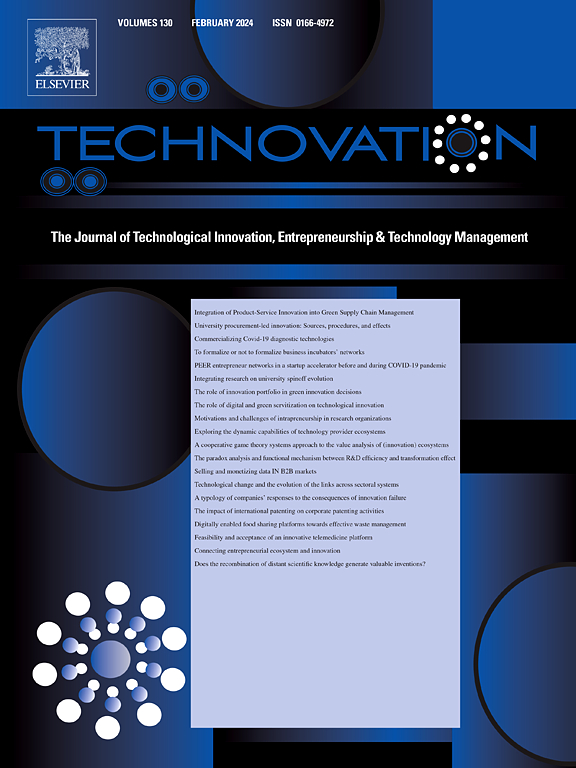导航电动汽车电池二次寿命循环生态系统的出现:企业和生态系统级相互作用的先决条件和途径
IF 10.9
1区 管理学
Q1 ENGINEERING, INDUSTRIAL
引用次数: 0
摘要
企业需要多方利益相关者的生态系统来成功创建和实施电动汽车(EV)电池二次寿命的循环商业模式。然而,目前明显缺乏指导工具来帮助电动汽车电池生态系统参与者制定和管理电池二次寿命运营策略。本研究的目的是分析循环生态系统是如何形成和管理的,考虑到企业层面和生态系统层面的相互作用。该研究确定了17个先决条件,分为循环生态系统管理的四个阶段,考虑到企业和生态系统层面之间的相互作用,以及短期和长期的观点。循环生态系统管理的这四个阶段是企业层面的评估、生态系统的形成、企业层面的适应和生态系统的协调。基于这四个阶段,该研究确定了三种不同的途径,通过这些途径,电动汽车电池生态系统参与者可以有效地形成和管理二次生命运营。此外,提出了一个决策树模型来引导生态系统参与者通过这四个阶段,以实现电池的二次寿命操作。该研究对生态系统管理和循环生态系统领域做出了有价值的贡献,特别是通过研究电动汽车电池二次寿命操作背景下企业层面和生态系统层面的动态之间的相互作用。这些发现对于寻求在电动汽车电池领域实施和扩大循环商业模式和循环生态系统的学术研究人员和实践者都具有重要意义。本文章由计算机程序翻译,如有差异,请以英文原文为准。
Navigating the emergence of circular ecosystems for electric vehicle battery second life: Prerequisites and pathways in firm- and ecosystem-level interactions
Firms require multi-stakeholder ecosystems to successfully create and implement circular business models for electric vehicle (EV) battery second life. However, there is a notable absence of guiding instruments to assist EV battery ecosystem actors in formulating and managing strategies for battery second-life operations. This study's aim is to analyze how circular ecosystems are formed and managed, considering the interplay between firm-level and ecosystem-level interactions. The study identifies 17 prerequisites divided into four stages of circular ecosystem management, considering the interplay between firm- and ecosystem-level aspects, as well as short- and long-term perspectives. These four stages of circular ecosystem management are firm-level assessment, ecosystem formation, firm-level adaptation, and ecosystem orchestration. Based on these four stages, the study identifies three distinct pathways through which EV battery ecosystem actors can effectively form and manage second-life operations. Additionally, a decision tree model is proposed to navigate ecosystem actors through these four stages for enabling battery second-life operations. This research makes a valuable contribution to the field of ecosystem management and circular ecosystems, specifically by examining the interplay between firm-level and ecosystem-level dynamics within the context of EV battery second-life operations. The findings hold significance for both academic researchers and practitioners seeking to implement and scale-up circular business models and circular ecosystems in the realm of EV batteries.
求助全文
通过发布文献求助,成功后即可免费获取论文全文。
去求助
来源期刊

Technovation
管理科学-工程:工业
CiteScore
15.10
自引率
11.20%
发文量
208
审稿时长
91 days
期刊介绍:
The interdisciplinary journal Technovation covers various aspects of technological innovation, exploring processes, products, and social impacts. It examines innovation in both process and product realms, including social innovations like regulatory frameworks and non-economic benefits. Topics range from emerging trends and capital for development to managing technology-intensive ventures and innovation in organizations of different sizes. It also discusses organizational structures, investment strategies for science and technology enterprises, and the roles of technological innovators. Additionally, it addresses technology transfer between developing countries and innovation across enterprise, political, and economic systems.
 求助内容:
求助内容: 应助结果提醒方式:
应助结果提醒方式:


